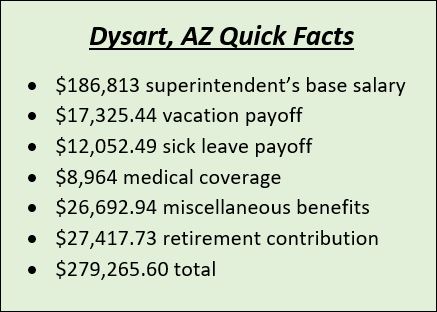SURPRISE, Ariz. – They seemed to have a good thing going in the Dysart, Arizona school district.
 The district received an A grade on its 2014-15 state report card, and several Dysart teachers received statewide honors for their efforts in recent years, according to a report from AzCentral.com.
The district received an A grade on its 2014-15 state report card, and several Dysart teachers received statewide honors for their efforts in recent years, according to a report from AzCentral.com.
MORE NEWS: Know These Before Moving From Cyprus To The UK
But trouble came in January 2015, when the school board voted to lay off 143 teachers for the 2015-16 school year to save $6 million.
The district’s revenue shortage was caused when voters turned down a budget override request, according to the news report.
Were the layoff notices given to teachers absolutely necessary? Perhaps. But a layman looking at the school’s payroll might wonder why some temporary adjustments couldn’t have been made – at least when it comes to benefits – so students wouldn’t be shortchanged.
In fiscal 2015-16, the district’s 1,390 teachers and other educators made a total of $50,251,752 in base salary, according to information provided by the school district. That put the average teacher salary at $36,152.
But the district also paid out $6,876,225 in retirement contributions on behalf of the teachers (an average of $4,946 per teacher) and $5,265,246 in other benefits, including medical and dental (an average of $3,787 per teacher).
Here’s a logical question: out of the $62.3 million the district spent on teacher salaries, benefits and retirement contributions, couldn’t $6 million have been squeezed out somewhere, to eliminate the deficit and keep all the teachers working?
MORE NEWS: How to prepare for face-to-face classes
 What about the retirement payments, which came to more than $6 million – the total amount that the district saved through the teacher layoffs? Couldn’t at least some of those payments have been delayed for a while, so the money could have been used for more urgent matters?
What about the retirement payments, which came to more than $6 million – the total amount that the district saved through the teacher layoffs? Couldn’t at least some of those payments have been delayed for a while, so the money could have been used for more urgent matters?
If not, why not? Are public school budgets so rigid and structured that changes can’t be made when extenuating circumstances arise?
During the school board meeting where the layoffs were approved, several citizens asked why the district couldn’t cut administrative salaries rather than teacher positions.
Jim Dean, the district’s assistant superintendent for support services, said that was a “great question,” according to AzCentral.com.
A great question, indeed, based on the labor costs associated with Superintendent Gail Pletnick in 2015-16.
She made a base salary of $186,813, according to the district – plus a whole lot more.
The district made a $27,417 retirement contribution on Pletnick’s behalf, she received $17,325 for a vacation payoff, $12,052 for a sick leave payoff, $15,375 for something listed as “add cabinet,” $9,999 for something called “add admin,” $8,964 in medical benefits, and several smaller payments.
Her total compensation for 2015-16 – including the retirement contribution – came to at least $279,265 – $92,452 more than her base salary.
If the superintendent costs the district that much, how much did other administrators cost? And how many administrators were there at the time? Could all the administrators been asked to sacrifice a bit to help offset the deficit and avoid the layoffs?
If not, why not?


Join the Discussion
Comments are currently closed.